In this tutorial, we will learn about one of the most important components of a system design: The Voltage Regulators. They are an essential part of a system or the power supply part of the system to be specific. We will learn about voltage regulators, what are the different types of voltage regulators, the principle of working of some of the important voltage regulators.
Outline
ToggleRole of a Power Supply
Before going into the details of a voltage regulator and the different types of voltage regulators, we will first take a look at the importance of power supply in system design.
Take any functioning system: an electronic wrist watch, a modern smart phone or a laptop computer. What do you think the biggest entity as a whole? It is the Power Supply.
The role of a Power Supply is to provide the system with a reliable, consistent and repeatable power to its components. In the context of electronic devices, a power supply must provide a constant, stable and regulated power for proper operation of the circuits.
So, what are the sources of Power Supply?
The two main sources of power supply are: 1. The AC Supply from our mains outlets and 2. DC Supply from batteries.
NOTE: The above list is based on readily available sources of power and the sources of energy.
Even though the power supply is readily available, it is not yet “system ready”. What does this mean? Let us understand this by taking the example of a computer system.
Typically, a computer system, or rather the electronics of the computer system require a regulated DC Voltage. The CPU works at 1.2V to 1.8V DC (depends on the CPU), the USB ports work at 5V DC, the mechanical hard disk drives require both 5V and 12V DC and so on.
If the voltage is above or below the required quantity, the component may not function or in a worst-case scenario it might get damaged beyond repair. So, it is important to “regulate” the voltage to the acceptable range.
This is where Voltage Regulators come into picture. The source can be AC power from mains outlet or DC power from batteries, the requirement of any electronic system is the same: a regulated DC Voltage.
Voltage Regulators
A Voltage Regulator is a device or a circuit that is responsible for providing a steady DC Voltage to an electronic load. The following image shows a typical power supply with voltage regulator.
As mentioned earlier, the job of a DC Power Supply is to take AC power from mains outlets (typically, 240V @ 50Hz) and convert it into steady DC Output. In this process, the AC voltage from the mains is first rectified with the help of a rectifier circuit to produce a pulsating DC voltage.
This pulsating DC is then filtered to produce a relatively smooth voltage. Finally, a Voltage Regulator produces a constant output voltage.
Components of a Voltage Regulator
Generally speaking, the Voltage Regulator stage of the power supply usually consists of three components:
- Feedback Circuit
- Stable Reference Voltage
- Pass Element Control Circuit
The process of voltage regulation is simple. The feedback circuit helps in sensing the variations in the output DC voltage. Depending on the feedback and the reference voltage, a control signal is then produced to drive the Pass Element to compensate the variations.
Speaking of the pass element, it is a solid-state semiconductor device like a PN Junction Diode, BJT Transistor or a MOSFET. Now, the output D Voltage is maintained almost constant.
Different Types of Voltage Regulators
Voltage Regulators can be implemented using discrete component circuits or ICs. Irrespective of the implementation, voltage regulators can be classified into two types:
- Linear Voltage Regulators
- Switching Voltage Regulators
Taking the above discussion on the components of a voltage regulator and its basic functionality into consideration, let us assume that the pass element in the voltage regulator circuit is a Transistor.
This transistor can be operated either in its active region or as a switch in order to regulate the output voltage. If the transistor stays in active region or the Ohmic region or Linear region of its operation during the course of voltage regulation, then the regulator is called as a Linear Voltage Regulator.
When the transistor operates in cutoff state and saturation state i.e. it switches between off state and saturation state, then the regulator is called as Switching Voltage Regulator.
Now, let us dive into both these voltage regulators and take a closer look at their working and types.
Linear Voltage Regulators
The original form of regulators in regulating power supplies are Linear Voltage Regulators. In a linear voltage regulator, the variable conductivity of the active pass element (usually a BJT or a MOSFET) is responsible for regulating the output voltage.
When a load is connected, the changes in either input or load will result in a variation in current through the transistor so that the output is maintained constant. For the transistor to be able to vary its current (collector-emitter current in case of a BJT), it must be operated in active or Ohmic region (also known as Linear Region).
During this process, the linear voltage regulator wastes a lot power as the net voltage i.e. the difference between the input and output is dropped in the transistor and is dissipated as heat.
Usually, linear voltage regulators are classified into five categories. They are:
- Positive Adjustable Regulators
- Negative Adjustable Regulators
- Fixed Output Regulators
- Tracking Regulators
- Floating Regulators
Example of Positive Adjustable Linear Voltage Regulators is the famous LM317 Regulator IC. The output voltage of LM317 can be adjusted between 1.2V and 37V.
Coming to Fixed Output Linear Voltage Regulators, the famous 78XX series of voltage regulator ICs fall under this category. 7805 is a commonly used fixed voltage regulator with 5V output.
Advantages of Linear Voltage Regulators
The advantages of Linear Voltage Regulators are as follows:
- Implementation of Linear Voltage Regulators is very simple and they are easy to use.
- In spite of their power dissipation, linear voltage regulators are robust in over current protection and thermal protection.
- Adjustable Voltage regulators require a very few external components to achieve its operation. Fixed voltage regulators require almost no external components (may be a couple of bypass capacitors).
- At low cost you have a wide range of voltage and current selection.
Disadvantages of Linear Voltage Regulators
The disadvantage of Linear Voltage regulators are as follows:
- Usually, linear voltage regulators are step down only i.e. the output voltage is always less than the input voltage.
- When operating from AC mains supply, a step-down transformer is required to bring the voltage to an operable level. Hence, they are usually bulky.
- As the regulation is done by dissipating excess power as heat, they tend to become extremely hot and the use of a heat sink is unavoidable.
- Also, the efficiency of linear regulators is usually very less, somewhere between 20% to 60%.
Further, Linear Voltage Regulators are again classified based on how the load is connected. They are:
- Series Voltage Regulators
- Shunt Voltage Regulators
Let us now briefly take a look at both these types of Linear Voltage Regulators.
Series Voltage Regulator
In a Linear Voltage Regulators, if the active pass element i.e. a transistor for example, is connected in series with the load, then it is known as a Series Voltage Regulators.
The following circuit shows a typical Linear Series Voltage Regulator.
In this circuit, the output voltage of the regulator is sensed through the voltage divider network R1 and R2. This voltage is compared to a reference voltage VREF. The resulting error signal will control the conduction of the Pass Transistor.
As a result, the voltage across the transistor is varied and the output voltage across the load is essentially maintained constant.
A type of series voltage regulator is a Zener Diode Voltage Regulator, which can maintain a constant voltage across the load.
This type of voltage regulator can reduce the ripple in the power supply and improve the regulation. But due to the non-zero Zener Resistance, the efficiency is low. This can be improved by limiting the Zener current.
Shunt Voltage Regulator
A Shunt voltage regulator is contrast to a Series voltage regulator. If the pass transistor in the linear voltage regulator is connected in parallel to the load, then the regulator is known as a Shunt Voltage Regulator.
Additionally, there is a voltage limiting resistor connected in series with the load. The following image shows a typical shunt voltage regulator.
In this circuit, the conduction of the transistor is controlled based on the feedback and reference voltage such that the current through the series resistor remains constant. As the current through transistor is varied, the voltage across the load remains essentially constant.
When compared to series regulators, shunt regulators are slightly less efficient but have a simpler implementation.
Switching Voltage Regulators
In both the Linear Voltage Regulators i.e. the Series Regulator and the Shunt Regulator, the active pass element i.e. the transistor is operating in its Linear region. By varying the conduction of the transistor, output voltage is maintained at a desirable level.
In contrast, a Switching Regulator operates slightly different than the Linear Regulator in the sense that the pass transistor acts as a switch i.e. it either stays in off state (cutoff region) or in on state (saturation region).
By adjusting the ON time of the pass transistor, the output voltage is maintained as a constant value.
Block diagram of a typical Switching Power Supply is shown below.
In fact, there is a separate tutorial on Switch Mode Power Supply or SMPS with the working, types and their operation as well. For more information, read “Switch Mode Power Supply”.
Advantages of Switching Voltage Regulator
- The main advantage of the Switching Power Supply or Switching Voltage Regulators is the efficiency. Usually, with a better design efficiency up to 95% can be achieved.
- As the transistor is oscillating between ON and OFF states, and the times it stays in active region is very less, the amount of power wasted is very less.
- The output voltage can be higher or lesser than the input voltage.
- Doesn’t need a step down or step up transformer but requires a tiny high frequency switching transformer.
Disadvantages of Switching Voltage Regulators
- The complexity of the design of switching power supply is very high.
- Due to frequent switching of the transistor and as a result the transistor current, there exists a high interference and noise.
Based on the design of the circuit, switching voltage regulators can be classified into two topologies.
- Non-isolated Converters
- Isolated Converters
In non-isolated converters, there are again several types but the important ones are:
- Step Down Voltage Regulator (Buck Converter)
- Step Up Voltage Regulator (Boost Converter)
- Buck / Boost Converter
In isolated converters, there are basically, two important types. They are:
- Flyback Converters
- Forward Converters
All these types are discussed in the Switch Mode Power Supply topic. So, refer to that document for more information.
Step Down Voltage regulator (Buck Converter)
In a Step Down Voltage regulator or a Buck converter, the output voltage is less than that of the input voltage. The following image shows a typical Buck Converter.
Step Up Voltage Regulator (Boost Converter)
In contrast to Buck Converter, a Boost Converter or a Step Up Voltage regulator provides a voltage that is higher at the output than the input.
The following image shows a typical Boost Converter.
There are many other Switching Voltage Regulator topologies like continuous, discontinuous, half-bridge, full-bridge, etc.

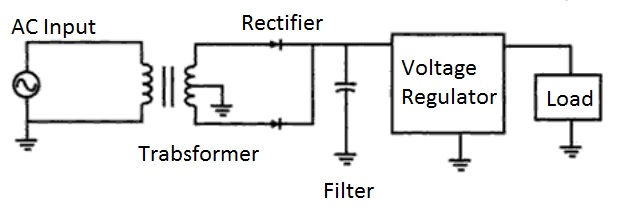
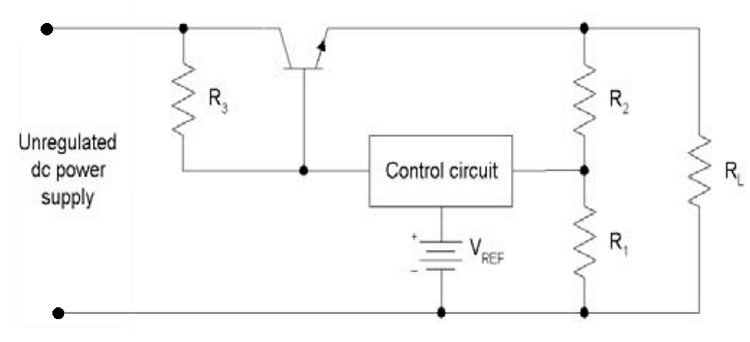
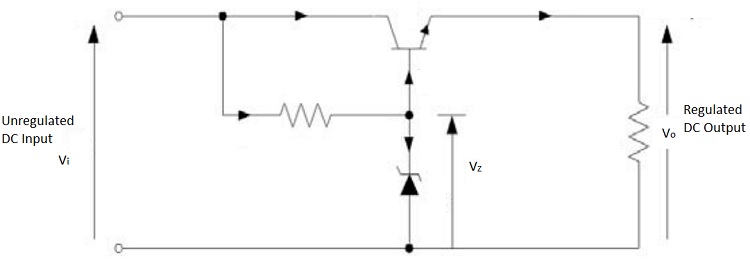
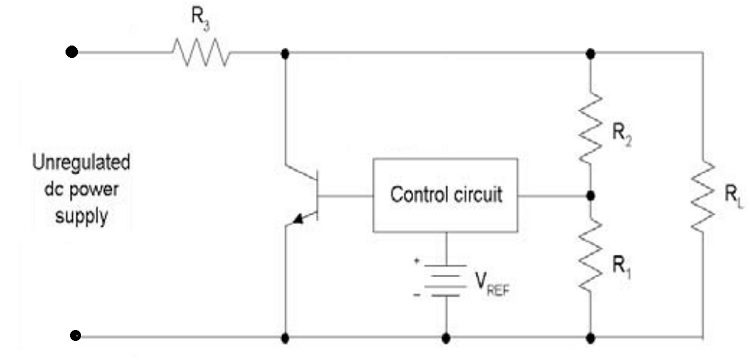
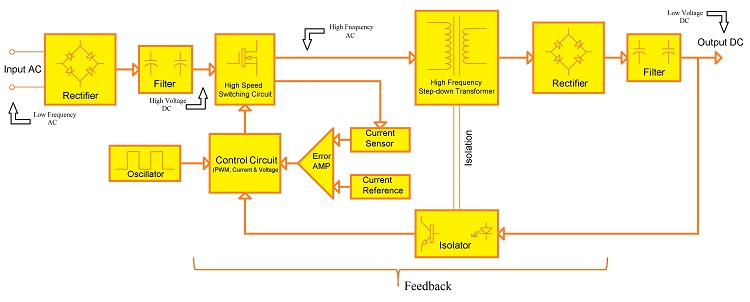
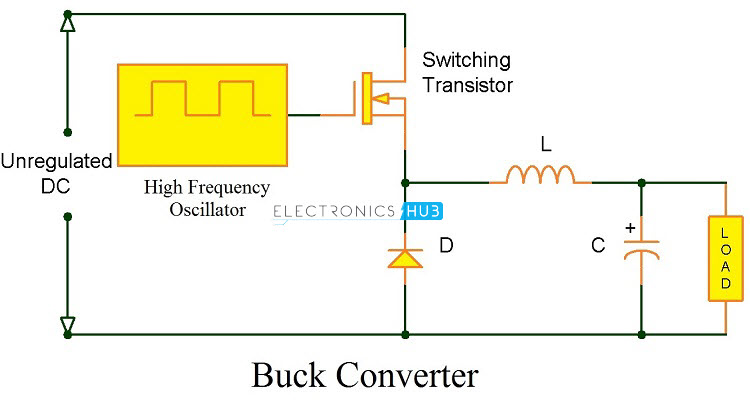
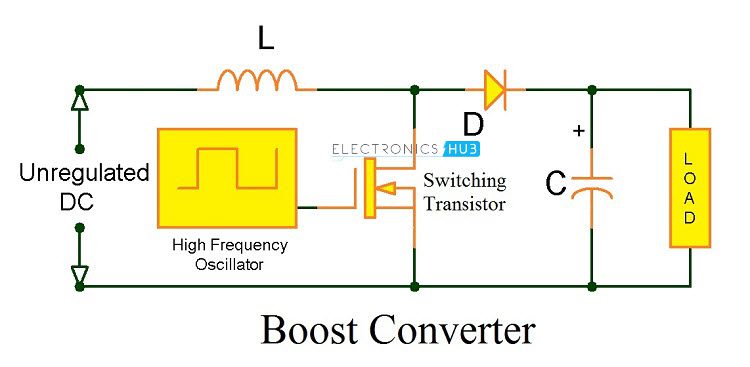

2 Responses
You Described very well i liked your work dear
VERY WELL DONE… WITH A GOOD GENERAL AND SPECIFIC DETAIL TUTORIAL ON VOLTAGE REGULATORS…A BIT ABOVE MY PAY GRADE….IF NOT A BIT MORE THAN EVEN THAT..!!!..BUT….. IF WE DONT AIM HIGH……WE MAY MISS OUR TARGET…. DUE TO GRAVITY AND INERTIA.!!!..THNKS SO MUCH…RATHER GET CLOSE ON A DIFFICULT TARGET THAN A BULLSEYE ON AN EASY LOW HANGING FRUIT VENTURE…MISS HIGN NEVER LOW..!!! GET LUCKY AND GET A FEW TOUGH PROJECTS DONE RIGHT TOO..BONUS POINTS..!!!! THNKS AGAIN…